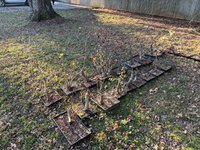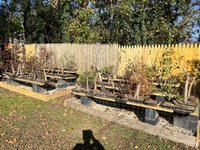Well, it's that time of year again and the threads on overwintering ideas are multiplying. Rather than simply trade ideas of WHAT we do to overwinter, let's discuss WHY we do it. Personally, when I'm thinking about caring for my trees over winter, my two main concerns are (i) preventing temperature fluctuations in the roots; and (ii) preventing desiccation on the top part of the tree. And I believe the two are inter-related. Depending on what we do, we also need to consider water, humidity, greenhouse effects, air flow and early budding.
Unlike a tree in the ground, trees in pots run the risk of their soil completely freezing solid. In addition, because these trees don't have the benefit of being insulated by the ground, they are subject to temperature fluctuations. There are multiple solutions to the problem. First, the trees should be placed on the ground to receive the benefit of the heat emanating from the earth's core. Pots can be placed near or in structures to "borrow" some of the heat retained in the structure. Lastly, and my personal favorite, the pots can be mulched in.
MY OCD just doesn't allow me to leave trees on the ground with nothing more. I also don't place any trees in the garage as I can't really water in there (and it's a filthy mess). Based on my very limited experience, I found that mulching does a better a job at preventing the entirety of the pots from freezing than placing them near a structure. I have also found that the mulch is excellent at maintaining a more constant temperature.
Which brings me to the above-ground portion of the tree. Assuming the roots are safe and sound, the top part of the tree, IMO, should just rough out the winter the way trees do. Of course, I realize that my opinion is largely based on living in zone 7b and having really only deciduous trees. That is, the biggest concern with the top of the tree is desiccation - and desiccation is a function of water loss getting ahead of the tree. If the soil isn't a block of ice because it is mulched, for example, I simply assume the tree will be able to get enough water, especially the deciduous trees (how much of a risk is desiccation with deciduous trees anyway?).
Again based on limited experience, I have not found that plastic coverings for the trees are effective at preventing freezing or maintaining temperature. As it doesn't seem to be helping the roots, I'm not sure how much assistance it is providing against desiccation. It would provide additional protection from wind (and give you full control over watering), but query whether wind or frozen roots is the main culprit here. Although I am still debating covering the mulch pile in a giant tent, I view it as more belt and suspenders than anything else in my situation (also not excited to spend $250).
This view is based on a guiding principal I use in bonsai - Trees belong outside and in the ground. When we change one or both of these, accommodations need to be made depending on the task at hand. My trees are outside and, once mulched, are "essentially" in the ground. So I kind of view the situation as nothing has been changed to the tree's natural living conditions and they should be able to use evolutionary skills to get them by without my interference (which likely just contributes to a more unnatural environment).
Hey I could be dead wrong and al my trees will die - hopefully y'all will chime in before then. I'm curious to hear other people's view points, and especially to hear from those who live in zones 5 and the like to understand WHY folks do what they do to get their (non-tropical) trees through winter.
P.S. I was checking out Walter Pall's thread on his garden and saw pics of his trees outside, covered in snow, on pedestals, in the middle of his yard with absolutely no winterizing. Hmmmmm. Making me rethink the need for a tent.
Unlike a tree in the ground, trees in pots run the risk of their soil completely freezing solid. In addition, because these trees don't have the benefit of being insulated by the ground, they are subject to temperature fluctuations. There are multiple solutions to the problem. First, the trees should be placed on the ground to receive the benefit of the heat emanating from the earth's core. Pots can be placed near or in structures to "borrow" some of the heat retained in the structure. Lastly, and my personal favorite, the pots can be mulched in.
MY OCD just doesn't allow me to leave trees on the ground with nothing more. I also don't place any trees in the garage as I can't really water in there (and it's a filthy mess). Based on my very limited experience, I found that mulching does a better a job at preventing the entirety of the pots from freezing than placing them near a structure. I have also found that the mulch is excellent at maintaining a more constant temperature.
Which brings me to the above-ground portion of the tree. Assuming the roots are safe and sound, the top part of the tree, IMO, should just rough out the winter the way trees do. Of course, I realize that my opinion is largely based on living in zone 7b and having really only deciduous trees. That is, the biggest concern with the top of the tree is desiccation - and desiccation is a function of water loss getting ahead of the tree. If the soil isn't a block of ice because it is mulched, for example, I simply assume the tree will be able to get enough water, especially the deciduous trees (how much of a risk is desiccation with deciduous trees anyway?).
Again based on limited experience, I have not found that plastic coverings for the trees are effective at preventing freezing or maintaining temperature. As it doesn't seem to be helping the roots, I'm not sure how much assistance it is providing against desiccation. It would provide additional protection from wind (and give you full control over watering), but query whether wind or frozen roots is the main culprit here. Although I am still debating covering the mulch pile in a giant tent, I view it as more belt and suspenders than anything else in my situation (also not excited to spend $250).
This view is based on a guiding principal I use in bonsai - Trees belong outside and in the ground. When we change one or both of these, accommodations need to be made depending on the task at hand. My trees are outside and, once mulched, are "essentially" in the ground. So I kind of view the situation as nothing has been changed to the tree's natural living conditions and they should be able to use evolutionary skills to get them by without my interference (which likely just contributes to a more unnatural environment).
Hey I could be dead wrong and al my trees will die - hopefully y'all will chime in before then. I'm curious to hear other people's view points, and especially to hear from those who live in zones 5 and the like to understand WHY folks do what they do to get their (non-tropical) trees through winter.
P.S. I was checking out Walter Pall's thread on his garden and saw pics of his trees outside, covered in snow, on pedestals, in the middle of his yard with absolutely no winterizing. Hmmmmm. Making me rethink the need for a tent.




